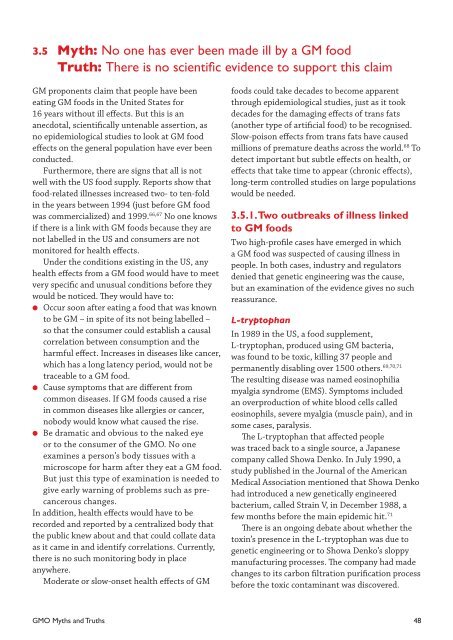GMO Myths and Truths
GMO Myths and Truths
GMO Myths and Truths
Create successful ePaper yourself
Turn your PDF publications into a flip-book with our unique Google optimized e-Paper software.
3.5 Myth: No one has ever been made ill by a GM food<br />
Truth: There is no scientific evidence to support this claim<br />
GM proponents claim that people have been<br />
eating GM foods in the United States for<br />
16 years without ill effects. But this is an<br />
anecdotal, scientifically untenable assertion, as<br />
no epidemiological studies to look at GM food<br />
effects on the general population have ever been<br />
conducted.<br />
Furthermore, there are signs that all is not<br />
well with the US food supply. Reports show that<br />
food-related illnesses increased two- to ten-fold<br />
in the years between 1994 (just before GM food<br />
was commercialized) <strong>and</strong> 1999. 66,67 No one knows<br />
if there is a link with GM foods because they are<br />
not labelled in the US <strong>and</strong> consumers are not<br />
monitored for health effects.<br />
Under the conditions existing in the US, any<br />
health effects from a GM food would have to meet<br />
very specific <strong>and</strong> unusual conditions before they<br />
would be noticed. They would have to:<br />
● Occur soon after eating a food that was known<br />
to be GM – in spite of its not being labelled –<br />
so that the consumer could establish a causal<br />
correlation between consumption <strong>and</strong> the<br />
harmful effect. Increases in diseases like cancer,<br />
which has a long latency period, would not be<br />
traceable to a GM food.<br />
● Cause symptoms that are different from<br />
common diseases. If GM foods caused a rise<br />
in common diseases like allergies or cancer,<br />
nobody would know what caused the rise.<br />
● Be dramatic <strong>and</strong> obvious to the naked eye<br />
or to the consumer of the <strong>GMO</strong>. No one<br />
examines a person’s body tissues with a<br />
microscope for harm after they eat a GM food.<br />
But just this type of examination is needed to<br />
give early warning of problems such as precancerous<br />
changes.<br />
In addition, health effects would have to be<br />
recorded <strong>and</strong> reported by a centralized body that<br />
the public knew about <strong>and</strong> that could collate data<br />
as it came in <strong>and</strong> identify correlations. Currently,<br />
there is no such monitoring body in place<br />
anywhere.<br />
Moderate or slow-onset health effects of GM<br />
foods could take decades to become apparent<br />
through epidemiological studies, just as it took<br />
decades for the damaging effects of trans fats<br />
(another type of artificial food) to be recognised.<br />
Slow-poison effects from trans fats have caused<br />
millions of premature deaths across the world. 68 To<br />
detect important but subtle effects on health, or<br />
effects that take time to appear (chronic effects),<br />
long-term controlled studies on large populations<br />
would be needed.<br />
3.5.1. Two outbreaks of illness linked<br />
to GM foods<br />
Two high-profile cases have emerged in which<br />
a GM food was suspected of causing illness in<br />
people. In both cases, industry <strong>and</strong> regulators<br />
denied that genetic engineering was the cause,<br />
but an examination of the evidence gives no such<br />
reassurance.<br />
L-tryptophan<br />
In 1989 in the US, a food supplement,<br />
L-tryptophan, produced using GM bacteria,<br />
was found to be toxic, killing 37 people <strong>and</strong><br />
permanently disabling over 1500 others. 69,70,71<br />
The resulting disease was named eosinophilia<br />
myalgia syndrome (EMS). Symptoms included<br />
an overproduction of white blood cells called<br />
eosinophils, severe myalgia (muscle pain), <strong>and</strong> in<br />
some cases, paralysis.<br />
The L-tryptophan that affected people<br />
was traced back to a single source, a Japanese<br />
company called Showa Denko. In July 1990, a<br />
study published in the Journal of the American<br />
Medical Association mentioned that Showa Denko<br />
had introduced a new genetically engineered<br />
bacterium, called Strain V, in December 1988, a<br />
few months before the main epidemic hit. 71<br />
There is an ongoing debate about whether the<br />
toxin’s presence in the L-tryptophan was due to<br />
genetic engineering or to Showa Denko’s sloppy<br />
manufacturing processes. The company had made<br />
changes to its carbon filtration purification process<br />
before the toxic contaminant was discovered.<br />
<strong>GMO</strong> <strong>Myths</strong> <strong>and</strong> <strong>Truths</strong> 48


